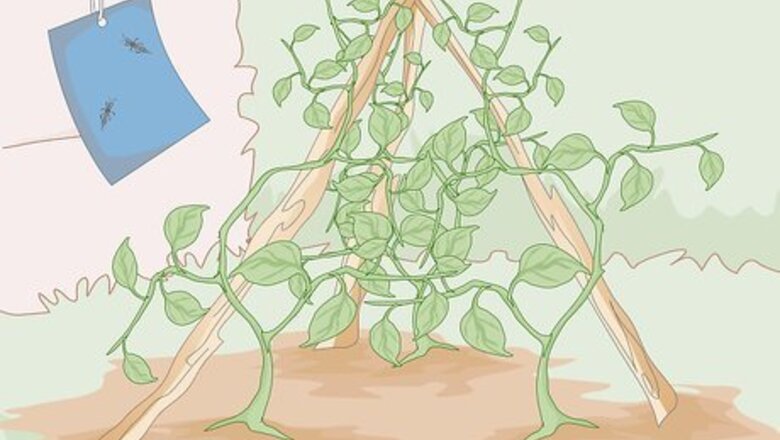
views
- Thrips feed in large groups, and they tend to be attracted to garden vegetables and flowers.
- Insecticidal soaps and neem oil are the most efficient way to spot-treat plants safely if they’re covered in thrips.
- Blue sticky traps are great at passively trapping thrips, but they’re also extremely helpful at monitoring how bad your problem is; if your traps turn up empty after a few weeks of treatment, consider the infestation solved!
- Avoid using chemical pesticides, since they’ll scare off ladybugs and other predatory bugs that will feed on the thrips.
- Thrips lay their eggs in small cuts along a plant’s stems, so it’s best to remove and discard any plants the thrips seem to be obsessed with if you want to keep the problem from coming back.
Eradicating Thrips with Aggressive Tactics
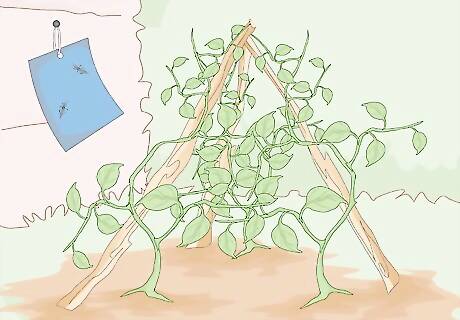
Install blue sticky traps to attract and catch thrips. Hang hole-punched, rectangular adhesive cards around your garden or greenhouse. After removing the adhesive backing paper, use a plastic tie to knot and secure each sticky sheet near any vents, doors, or other openings that a thrips bug could pass through. Monitor how many thrips are caught on each card over the span of 1 week, then replace the sheet with a new sticky trap. Sticky card traps come in both yellow and blue. Blue cards tend to attract only thrips, while yellow cards attract a variety of garden pests. You can find both at your local garden supply store. These traps work especially well in an indoor garden or greenhouse. You can use these traps to figure out how severe your thrips problem is.Did you know? It’s not necessarily bad if you find thrips in your garden or greenhouse. There are a variety of thrips species, including a parasitic group that feeds on other thrips. Don’t worry about an infestation unless you see physical damage to your flowers and crops.

Introduce predatory bugs to kill off the thrips population. Check your local gardening store or a specialty website for thrips predators that you can introduce to your garden or greenhouse. Opt for bugs like mites, green lacewings, and minute pirate bugs, or other predatory pests, like parasitic wasps. Before introducing any new species to your garden, speak with a horticulture specialist to see what options are best for your garden. These predatory bugs exist naturally in some gardens. To welcome these predators into your space, include a variety of different plant species in your garden.

Use reflective mulch wrap to disorient bugs. Catch any thrips off-guard by insulating your flowers and crops with reflective mulch wrap. After you mulch your garden, unroll a tube of silver or gray reflective mulch wrap directly next to your row of plants. Use bricks or cinder blocks to hold the gray or silver wrap in place, so it doesn’t blow away. To finish the process, arrange and secure another section of reflective mulch along the opposite, uncovered side of your plant row. You can apply reflective mulch at the beginning of the season, before any crops sprout. If possible, opt for a silver or gray reflective mulch. You can typically find this product at your local home improvement or garden supply center.

Spray an insecticide every 5 days. Use a sprayer to spritz the surface of your plants with azadirachtin, or another insecticide with low toxicity levels. For the most efficiency, apply the insecticide once every 5 days. After 2 months, switch to a new insecticide so the thrips won’t develop immunity. Don’t be discouraged if you don’t see any immediate results; depending on the circumstances, you might not notice any improvements until the next gardening season. If you’re looking for a more natural insecticide option, try spinosad. If you have them set up, use your sticky traps to monitor the population of thrips in your garden while you use insecticides.
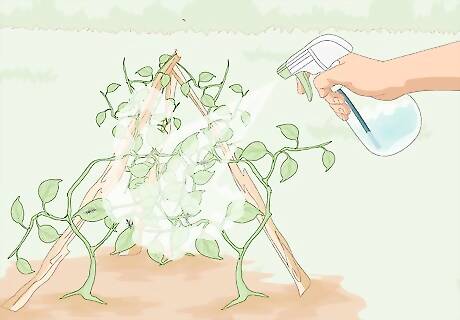
Spritz the plants with insecticidal soap as a natural measure. Look in your local garden supply store for insecticidal soaps, which provide a more natural, oil-based option to eliminate the thrips in your garden. Every 4 to 7 days, use a spray bottle or insecticide sprayer filled with soap and distilled water to coat your plants. To prevent any damage to your plants, rinse off any soapy crops 1-2 hours after you applied the insecticide. Be careful with insecticides—even if you’re killing off the thrips, you might also be killing off valuable bug species in the process. Neem oil is also a natural insecticide treatment against thrips.
Preventing Infestations with Regular Crop Maintenance

Monitor your plants for signs of feeding marks and bug feces. Try to inspect your plants on a daily or weekly basis during the active gardening season. Be on the lookout for signs of thrips damage, such as white, discolored sections on different parts of the plant. Additionally, search for thrips feces, which look like a collection of small, pinhead-sized black dots. Thrips target a variety of crops and flowers; however, they aren’t attracted to shrubs or trees. Additionally, these pests aren’t specific to a single climate or gardening area. Unfortunately, there’s no way to reverse thrips damage to plants.Tip: When adding any new crops or flowers to your garden, thoroughly inspect these imported plants for signs of a thrips infestation. You don’t want to expose your healthy crops to an infected plant!
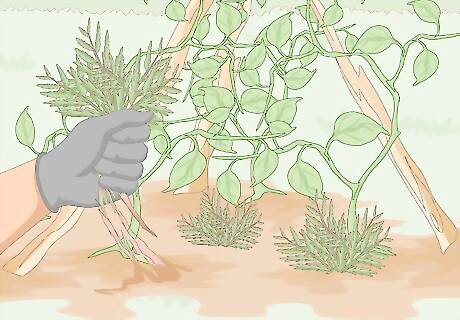
Remove any weeds to reduce the thrips’ nesting area. Check around your flowers and crops for any sign of weeds. Use your hands or a specialized garden tool to remove these unwanted plants by the root, so they won’t grow back. If your garden is clean and orderly, then thrips won’t have as much surface area to land and snack on.
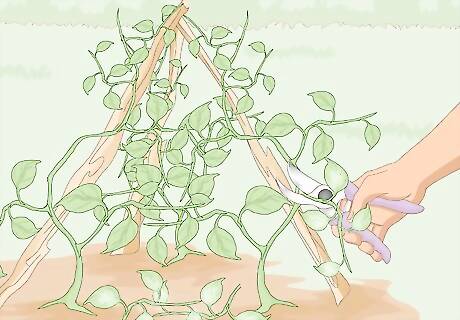
Prune plants regularly to get rid of infested branches and leaves. Avoid shearing off small portions of leaves. Instead, use a pair of garden clippers to trim off any infested branches, buds, or nodes. Try to keep track of when your plants are in full bloom, so you can trim and prune these crops effectively. For instance, trim off any twisted branches from an Indian laurel fig tree during the winter months, so thrips won’t infest the plant later on.

Check that your plants are getting the right amount of sun and fertilizer. Maintain a consistent schedule while feeding and tending to the different plants in your garden. Try to feed and fertilize your crops on a regular, consistent basis, so your plants will be strong enough to survive any thrips infestations. Additionally, note which of your plants need direct sunlight and which need shade, then arrange them accordingly—this way, they won’t be as susceptible to an infestation. For instance, if you plant sun-dependent flowers like pansies in a shady, darker area, they may be more susceptible to thrips. Avoid using too much nitrogen-based fertilizer, as this can encourage more thrips to infest your garden.


















Comments
0 comment